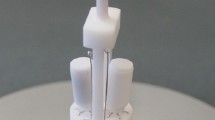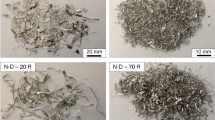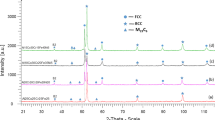Abstract
Three alloys based on Fe–C–Cr were studied. These alloys contained carbon in a range of 0.308–0.380 mass% and chromium 1.058–4.990 mass%. Temperatures of solidus (onward used as TS), liquidus (onward used as TL) and peritectic transformation (onward used as TP) were studied in the high-temperature region. These temperatures were obtained using two thermal analysis methods: differential thermal analysis (onward used as DTA) and simple thermal analysis (onward used as TA). The Setaram Setsys 18TM was used for experiments with employment of the DTA method. All measurements were taken in an inert atmosphere of pure argon at heating rate of 10 °C min−1, and simple TA method was used for the experiments with the use of the Netzsch STA 449 F3 Jupiter. Measurements were taken in inert atmosphere of pure argon at a heating and cooling rate of 5 °C min−1. Phase transformation temperatures were obtained by heating and cooling process and were approximated to “equilibrium conditions” (DTA method: zero heating rate and sample mass, standard, TA method: only standard) (Žaludová et al. in J Therm Anal Calorim 112:465–471, 2013a. doi:https://doi.org/10.1007/s10973-012-2847-8; J Therm Anal Calorim 111:1203–1210, 2013b. doi:https://doi.org/10.1007/s10973-012-2346-y). The experimental data were compared and discussed with the calculation results using IDS (solidification analysis package) software (onward used as SW) Thermo-Calc and the TCFE8 (Thermo-Calc Fe-based alloys) database. The results of the two alloys were compared with those published for similar steels. The experimentally obtained transition temperatures were close to the calculated values. The solidus, liquidus and peritectic transformation temperatures were lowered with increasing carbon (range 0.308–0.380 mass%) and chromium content (range 1.058–4.990 mass%). The smallest difference between the experimental results and theoretical calculations was observed at the liquidus temperature for all alloys. Nonetheless, the difference measured for the solidus temperatures was much greater.






Similar content being viewed by others
References
Žaludová M, Smetana B, Zlá S, Dobrovská J, Watson A, Vontorová J, Rosypalová S, Kukutschová J, Cagala M. Experimental study of Fe–C–O based system above 1,000 °C. J Therm Anal Calorim. 2013;112:465–71. https://doi.org/10.1007/s10973-012-2847-8.
Žaludová M, Smetana B, Zlá S, Dobrovská J, Vodárek V, Konečná K, Matějka V, Matějková P. Experimental study of Fe–C–O based system below 1000 °C. J Therm Anal Calorim. 2013;111:1203–10. https://doi.org/10.1007/s10973-012-2346-y.
Tajima M, Umeyama Y. Latent heats of phase transformations in iron and steel. High Temp High Press. 2002;34:91–7.
Edmonds DV, Pereloma E. Phase transformations in steels. Volume 1: Fundamentals and diffusion—controlled transformations. Cambridge: Woodhead Publishing Limited; 2012.
Myslivec T. Physical-chemical foundations of steel industry. 2nd ed. Praha: SNTL—Technical literature publishing house; 1971.
Thermo-Calc Software TCFE8 Steels/Fe-alloys database version 8. Accessed June 15, 2017.
Kawuloková M, Smetana B, Zlá S, Kalup A, Mazancová E, Váňová P, Kawulok P, Dobrovská J, Rosypalová S. Study of equilibrium and nonequilibrium phase transformations temperatures of steel by thermal analysis methods. J Therm Anal Calorim. 2017. https://doi.org/10.1007/s10973-016-5780-4.
Bolzano B. Steel in motion. http://www.bolzano.cz/. Accessed Oct 15, 2017.
Ryš P, Cenek M, Mazanec K, Hrbek A. Material science I, metal science 4. 1st ed. Praha: Academia; 1975.
Kalup A, Smetana B, Kawuloková M, Zlá S, Francová H, Dostál P, Waloszková K, Waloszková L, Dobrovská J. Liquidus and solidus temperatures and latent heats of melting of steels. J Therm Anal Calorim. 2017. https://doi.org/10.1007/s10973-016-5942-4.
Smetana B, Zlá S, Kawuloková M, Gryc K, Strouhalová M, Kalup A, Tkadlečková M, Dobrovská J, Michalek K, Jonšta P, Sušovský M, Dostal P, Martiník O, Drozdová Ľ. Temperatures of solidus and liquidus of tool steel. In: Proceedings paper, METAL 2016: 25th anniversary international conference on metallurgy and materials, p. 91–6. ISBN 978-80-87294-67-3.
Martiník O, Smetana B, Dobrovská J, Kalup A, Zlá S, Kawuloková M, Gryc K, Dostál P, Drozdová Ľ, Baudišová B. Prediction and measurement of selected phase transformation temperatures of steels. J Min Metall Sect B Metall. 2017. https://doi.org/10.2298/JMMB170711030M.
Cabrera-Marero JM, Carreño-Galindo V, Morales RD, Chávez-Alcalá F. Macro-micro modeling of the dendritic microstructure of steel billets processed by continuous casting. ISIJ Int. 1998. https://doi.org/10.2355/isijinternational.38.812.
Štětina J. Dynamic model of temperature field of continuously cast slabs. Ph.D. thesis, VŠB-TU Ostrava. http://ottp.fme.vutbr.cz/users/stetina/disertace/index.htm. Accessed Oct 17, 2017.
Han Z, Cai K, Liu B. Prediction and analysis on formation of internal cracks in continuously cast slabs by mathematical models. ISIJ Int. 2001. https://doi.org/10.2355/isijinternational.41.1473.
Gallagher PK. Handbook of thermal analysis and calorimetry: principles and practice, vol. 2. 1st ed. Amsterdam: Elsevier; 2003.
Jernkontoret. A guide to the solidification of steels. Technical Report. Stockholm; 1977.
MTDATA—Phase Diagram Software from the National Physical Laboratory. http://www.npl.co.uk/science-technology/mathematics-modelling-and-simulation/mtdata/. Accessed June 16, 2017.
Pandat Software. http://www.computherm.com/. Accessed June 16, 2017.
FactSage. The integrated thermodynamic databank system. http://www.crct.polymtl.ca/factsage/fs_general.php. Accessed June 16, 2017.
Sopoušek J. Phase equilibria and diffusion-controlled processes in selected systems of metals and their alloys (commentary). Brno: MU in Brno, Science Faculty, Chemical Institute; 2002.
Lašček M. Specific heat capacity of austenitic chrome-nickel steel Cr18Ni9. In: Acta Metallurgica Slovaca. http://www.ams.tuke.sk/data/ams_online/2008/number1/mag04/mag04.pdf. Accessed June 17, 2017.
Andersson JO, Helander T, Höglund L, Shi P, Sundman B. Thermo-Calc & DICTRA, computational tools for materials science. Calphad. 2002;26:273–312.
Miettinen J. Solidification analysis package for steels-user´s manual of DOS version 2.0.0. Helsinki: University of Technology; 1999.
Acknowledgements
This paper was created on the Faculty of Metallurgy and Materials Engineering in the Project No. LO1203 “Regional Materials Science and Technology Centre—Feasibility Program” funded by Ministry of Education, Youth and Sports of the Czech Republic, GAČR Project No. 17-18668S and student project SP2017/59.
Author information
Authors and Affiliations
Corresponding author
Rights and permissions
About this article
Cite this article
Drozdová, Ľ., Smetana, B., Zlá, S. et al. Study of phase transformation temperatures of alloys based on Fe–C–Cr in high-temperature area. J Therm Anal Calorim 133, 41–48 (2018). https://doi.org/10.1007/s10973-018-7012-6
Received:
Accepted:
Published:
Issue Date:
DOI: https://doi.org/10.1007/s10973-018-7012-6




